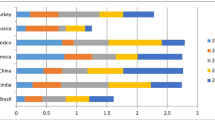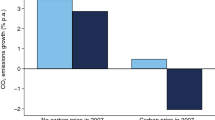Abstract
Turkey’s electricity market has undergone extensive reform since 2001 through market liberalization, unbundling, privatization, the establishment of organized power markets, retail market opening, and the establishment of an independent energy regulatory authority. We use a computable general equilibrium model to test the impact of power sector reform on the economy. We construct Turkey’s social accounting matrix for 2010 by disaggregating it into energy accounts. Major findings suggest that the reform has, for a major part, been beneficial to the economy. We find that GDP increases by 0.35% from the baseline when monopolistic rent is reduced simultaneously at all state-run power companies, suggesting that the economy would be better off with these firms behaving as competitive agents in the market, rather than using their dominant position to intervene in the market. One alternative is wider participation of state-run utilities in the day-ahead market, which leads to a 0.25% increase in GDP. Our findings also suggest that the introduction of the day-ahead market and privatization of state-run utilities are positively related to economic growth.

Data source: Turkish Statistical Institute

Source: TEIAS

Source: TEIAS



Source: EPIAS

Source: EPIAS
Similar content being viewed by others
Notes
For the politics of electricity market reforms in Turkey, see Çetin and Oğuz [13].
A pioneering work that incorporates internal scale economies for an industry is Harris [25].
Based on information acquired during interviews with market participants.
The most expensive source for electricity generation is oil, followed by natural gas and lignite. We assume that lignite-fired and imported coal or hard-coal fired electricity generation costs are the same. We also assume that the cost of renewable energy is the same for all types of renewable resources (29 Turkish Liras per MWh in 2010). It is worth noting that fuel costs are zero for renewable energy, and hence, only operating expenses are considered.
Specifically, we assume that the exchange rate is equal to 1 in the base data, thereby initially equating world prices (which are exogenous) to 1. After a shock is given, the model solves for the equilibrium real exchange rate.
Peak hours typically refer to 08:00–20:00 during the day.
Off-peak hours refer to the 00:00–08:00 and 20:00–24:00 intervals for a given day.
The decline in GDP in simulation 1.1 and 1.2 is interesting. In our model, GDP is defined as the sum of private and public spending, private and public investments, and net exports. The change in GDP is the sum of the changes in these components. Government spending declines in both scenarios, and the appreciation of the exchange rate worsens the next exports. Therefore, although private consumption increases in both scenarios, the net effect on GDP is a slight decline.
The elasticity of transformation between domestic goods and exports for producers in the baseline is set as 1.25 and cannot go below 1. Therefore, we do not choose a value lower than this.
High long-run unemployment rate above 10% is a general characteristic for the Turkish economy. It is generally believed that the long-run natural rate of unemployment is very high.
See, for example, http://www.world-nuclear.org/information-library/country-profiles/countries-t-z/appendices/nuclear-development-in-the-united-kingdom.aspx. Accessed on 1 November 2018.
References
Akkemik, K. (2009). Cost function estimates, scale economies and technological progress in the Turkish electricity generation sector. Energy Policy, 37(1), 204–213.
Akkemik, K., & Li, J. (2015). General equilibrium evaluation of deregulation in energy sectors in China. Journal of Chinese Economic and Business Studies, 13(3), 247–268.
Akkemik, K., & Oguz, F. (2011). Regulation, efficiency and equilibrium: a general equilibrium analysis of liberalization in the Turkish electricity market. Energy, 36(5), 3282–3292.
Atiyas, I., Çetin, T., & Gülen, G. (2012). Reforming turkish energy markets chap regulatory reform and competition in the Turkish electricity industry (pp. 15–62). New York: Springer.
Aydin, L. (2010). The economic and environmental impacts of constructing hydro power plants in Turkey: a dynamic CGE analysis (2004–2020). Natural Resources, 1(2), 69–79.
Bagdadioglu, N., & Odyakmaz, N. (2009). Turkish electricity reform. Utilities Policy, 17(1), 144–152.
Bagdadioglu, N., Price, C., & Weyman-Jones, T. (2007). Measuring potential gains from mergers among electricity distribution companies in Turkey using a non- parametric model. Energy Journal, 28, 83–110.
Bahçe, S., & Taymaz, E. (2008). The impact of electricity market liberalization in Turkey: “free consumer” and distributional monopoly cases. Energy Economics, 30(4), 1603–1624.
Baş, F., & Ülgen, N. (2008). Elektrik piyasasının serbestleşmesi ve arz güvenliğinin sağlanması için öneriler. Tech. rep. Turkish Industry and Business Association (TÜSİAD), Energy Strategy Series, paper no. T/2008-05/460
Bhattacharyya, R., & Ganguly, A. (2017). Cross subsidy removal in electricity pricing in India. Energy Policy, 100, 181–190.
Camadan, E., & Kölmek, F. (2013). A critical evaluation of Turkish electricity reform. Electricity Journal, 26(1), 59–70.
Çelen, A. (2013). Efficiency and productivity (TFP) of the Turkish electricity distribution companies: an application of two-stage (DEA&Tobit) analysis. Energy Policy, 63, 300–310.
Çetin, T., & Oğuz, F. (2007). Politics of regulation in the Turkish electricity market. Energy Policy, 35(3), 1761–1770.
Çetin, T., & Yilmaz, F. (2010). Transition to the regulatory state in Turkey: lessons from energy. Journal of Economic Issues, 44(2), 393–402.
Chen, S., & He, L. (2013). Deregulation or governmental intervention? a counterfactual perspective on China’s electricity market reform. China and World Economy, 21, 101–120.
Chisari, O., Estache, A., & Romero, C. (1997). Winners and losers from utility privatization in Argentina: lessons from a general equilibrium model. Tech. rep., World Bank Economic Development Institute, Policy Research working paper no. 1824
Coupal, R., & Holland, D. (2002). Economic impact of electric power industry deregulation on the State of Washington: a general equilibrium analysis. Journal of Agricultural and Resource Economics, 27(1), 244–260.
DPT (2009) Strategy paper on energy market and security of supply. DPT (State Planning Office), Ankara
EMRA (2012) Elektrik PiyasasıGelişim Raporu 2011 (Electricity Market Development Report 2011. EMRA (Energy Markets Regulatory Authority), Ankara
Enerji, A., (2014). Investor presentation March 2014
Erdoğdu, E. (2007). Regulatory reform in Turkish energy industry: an analysis. Energy Policy, 35(2), 984–993.
Erdogdu, E. (2011). The impact of power market reforms on electricity price-cost margins and cross-subsidy levels: a cross country panel data analysis. Energy Policy, 39(3), 1080–1092.
Erten, H., (2009). Türkiye için sektörel sosyal hesaplar matrisi üretme yöntemi ve istihdam üzerine bir hesaplanabilir genel denge modeli uygulaması. Tech. rep. State Planning Organization (DPT), Ankara
Gelan, A. (2018). Economic and environmental impacts of electricity subsidy reform in Kuwait: a general equilibrium analysis. Energy Policy, 112, 381–398.
Harris, R. (1984). Applied general equilibrium analysis of small open economies with scale economies and imperfect competition. American Economic Review, 74(5), 1016–1032.
Hosoe, N. (2006). The deregulation of Japan’s electricity industry. Japan and the World Economy, 18(2), 230–246.
Hwang, W., & Lee, J. (2015). A CGE analysis for quantitative evaluation of electricity market changes. Energy Policy, 83, 69–81.
Karahan, H., & Toptas, M. (2013). The effect of power distribution privatization on electricity prices in Turkey: has liberalization served the purpose? Energy Policy, 63, 614–621.
Kat, B., Paltsev, S., & Yuan, M. (2018). Turkish energy sector development and the Paris Agreement goals: a CGE model assessment. Energy Policy, 122, 84–96.
Kerkela, L., (2004). Distortion costs and effects of price liberalisation in russian energy markets: A CGE analysis. Bank of Finland, Institute for Economies in Transition (BOFIT) Discussion Papers, No. 2/2004
Kumbaroglu, G. (2003). Environmental taxation and economic effects: a computable general equilibrium analysis for Turkey. Journal of Policy Modelling, 25(8), 795–810.
Küster, R., Ellersdorfer, I., & Fahl, U. (2007). A CGE analysis of energy policies considering labor market imperfections and technology specifications. FEEM Working Paper no. 7.
Lofgren, H., Harris, R., & Robinson, S., (2002). A standard computable general equilibrium (cge) model in gams. Tech. rep., International Food Policy Research Institute, Washington DC
Lu, C., Zhang, X., & He, J. (2010). A CGE analysis to study the impacts of energy investment on economic growth and carbon dioxide emission: a case of Shaanxi Province in western China. Energy, 35(11), 4319–4327.
Madlener, R., Kumbaroğlu, G., & Ediger, V. (2005). Modeling technology adoption as an irreversible investment under uncertainty: the case of the Turkish electricity supply industry. Energy Economics, 27(1), 139–163.
MENR (2014) Elektrik enerjisi piyasası strateji belgesi taslağı[electricity market strategy paper draft]
Oğuz, F. (2010). Competition by regulation in energy markets: the case of Turkey. European Journal of Law and Economics, 30(1), 41–58.
Oğuz, F., Akkemik, K., & Göksal, K. (2014). Can law impose competition? a critical discussion and evidence from the Turkish electricity generation market. Renewable and Sustainable Energy Reviews, 30, 381–387.
Ozkivrak, O. (2005). Electricity restructuring in Turkey. Energy Policy, 33(10), 1339–1350.
PWC (2011). Analysis of the effects of liberalization on the Turkish energy market. Price Waterhouse Coopers, November (2011)
Riipinen, T. (2003). Energy market liberalisation in the FSU: simulations with the GTAP model. Tech. rep., Bank of Finland, Institute for Economies in Transition (BOFIT) Discussion Papers, No. 12/2003
Şenerdem, E. D., & Akkemik, K. A. (2017). An electricity-based social accounting matrix for Turkey for 2010. Network Industries Quarterly, 19(2), 6–9.
Song, M., & Cui, L. (2016). Economic evaluation of Chinese electricity price marketization based on dynamic computational general equilibrium model. Computers and Industrial Engineering, 101, 614–628.
TEIAS. (2012). Türkiye Elektrik Enerjisi 10 Yıllık Üretim Kapasite Projeksiyonu (2012–2021). Ankara: TEIAS.
Telli, C., (2004). Sosyal hesaplar matrisi üretme yöntemiyle Türkiye uygulaması. Tech. rep. State Planning Organization (DPT), Ankara
Tiryaki, R. (2013). The evolution of Turkish electricity market regulation. In: Competition and regulation in network industries. CRNI conference proceedings, Brussels, Belgium
Ulusoy, U., & Oguz, F. (2007). The privatization of electricity distribution in Turkey: a legal and economic analysis. Energy Policy, 35(10), 5021–5034.
USAID (2006). Efficiency factor’s determination. Tech. rep. ERRA Tariff/Pricing Committee, Kema International
Willenbockel, D. (1994). Applied general equilibrium modelling: imperfect competition and European integration. West Sussex, England: Wiley.
Yin, J., Yan, Q., Lei, K., Balezentis, T., & Streimikiene, D. (2019). Economic and efficiency analysis of China electricity market reform using computable general equilibrium model. Sustainability, 11(2), 350.
Zhang, F. (2015). Energy price reform and household welfare: the case of Turkey. Energy Journal, 36(2), 71–95.
Author information
Authors and Affiliations
Corresponding author
Additional information
Publisher's Note
Springer Nature remains neutral with regard to jurisdictional claims in published maps and institutional affiliations.
Electronic supplementary material
Below is the link to the electronic supplementary material.
Rights and permissions
About this article
Cite this article
Dautaj Şenerdem, E., Akkemik, K.A. Evaluation of the reform in the Turkish electricity sector: a CGE analysis. IJEPS 14, 389–419 (2020). https://doi.org/10.1007/s42495-020-00038-x
Received:
Accepted:
Published:
Issue Date:
DOI: https://doi.org/10.1007/s42495-020-00038-x




